BLIND SPOT WARNING
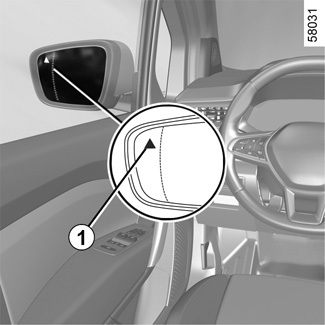

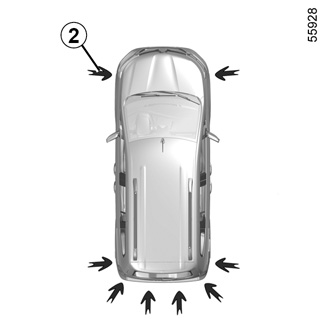
Depending on the vehicle, there are two types of blind spot warning system:
- System A: uses information from ultrasonic sensors fitted in the vehicle bumpers. When activated, the system A can be identified by indicator light 1 flashing each time the engine starts;
- System B: uses information from the radars fitted on each side of the rear bumper. When activated, the system B can be identified by indicator light 1 not flashing each time the engine starts.
A system
Using information from the ultrasonic sensors indicated by the arrows 2, that are fitted in the vehicle bumpers, the system notifies the driver when another vehicle appears in the detection zone C.
The system is activated when the vehicle speed is between approximately 18 mph (30 km/h) and 80 mph (130 km/h).
This function is an additional driving aid. This function is not under any circumstances intended to replace the due care and attention of the driver, who should at all times be in control of the vehicle.
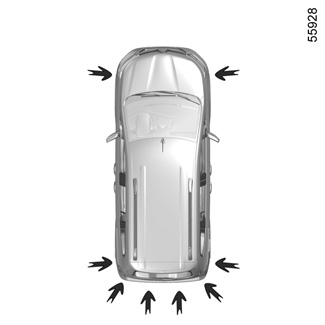

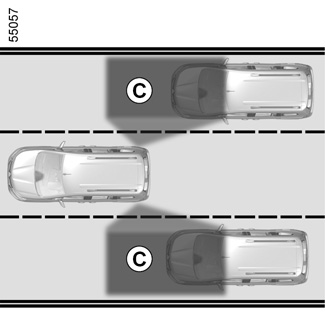
A system
(continued)
Special feature
Ensure that the ultrasonic sensors installed in the vehicle bumpers are not obscured (by dirt, mud, snow etc.).
If one of the sensors is obscured, the message “Side radars no visibility” will appear on the instrument panel. Clean the ultrasonic sensor zones.
Indicator 1
An indicator light 1 is located on each rear view mirror 3.
Note: clean the rear view mirrors 3 regularly so that the indicators 1 can be seen.
Operation
The function alerts you if your vehicle speed is between approximately 18 mph (30 km/h) and 80 mph (130 km/h) while another vehicle is in the blind spot C and moving in the same direction as your vehicle.
If you overtake another vehicle, the indicator 1 will only come on if that vehicle remains for a long enough period in your vehicle’s blind spot C.
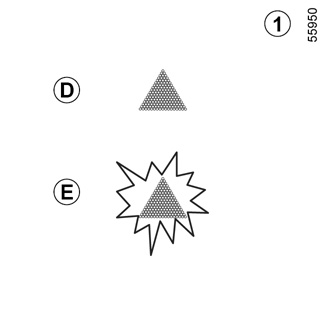
A system
(continued)
Display D
First warning: when the direction indicator is not activated, the 1 warning light signals that a vehicle is detected in the blind spot.
Display E
Direction indicator activated, the 1 warning light flashes when the function detects a vehicle in the blind spot warning area and/or a vehicle is rapidly approaching from the rear on the side towards which you will turn the wheel. If you cancel the direction indicator, the function will return to the initial warning (display D).
Conditions for non-function
- When driving on a road with tight bends;
- in reverse;
- speed below 18 mph (30 km/h);
- speed above 80 mph (130 km/h).
If the vehicle is equipped with a towbar recognised by the system, the “Trailer: side radars OFF” message displayed on the instrument panel informs you that the function is not operational. For information on the range of equipment adapted to your vehicle, we advise you to consult an approved Dealer.
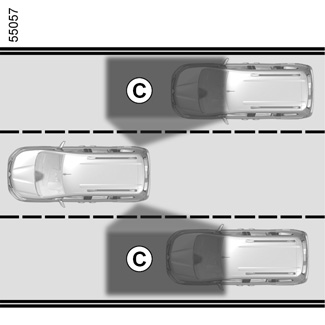
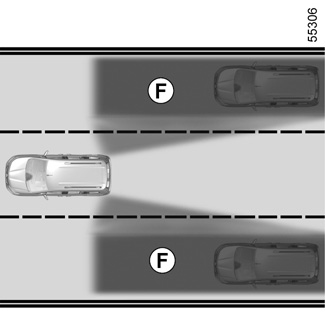

B system
Using information from the sensors installed on each side of the rear bumper (area G), the function warns the driver:
- when another vehicle appears in the detection area C;
and/or
- when there is a risk of collision with a vehicle that is in area F, driving faster than you.
The function warns you when the vehicle is travelling at a speed above approximately 9 mph (15 km/h).
Special feature
Ensure that the G area around the radars on each side of the rear bumper are not obstructed (by dirt, mud, snow etc.)
If a radar is obscured, the message “Side radars no visibility” will appear on the instrument panel. Clean the radar area.
This function is an additional driving aid. This function is not under any circumstances intended to replace the due care and attention of the driver, who should at all times be in control of the vehicle.

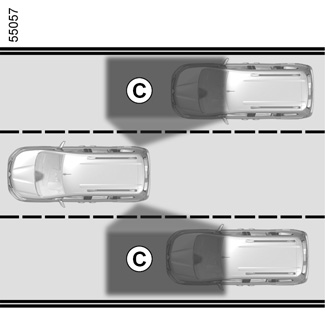
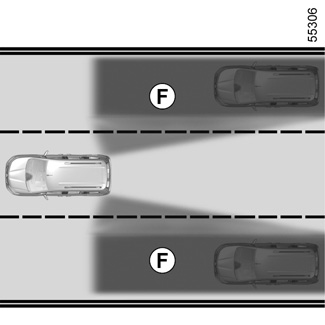
B system
(continued)
Indicator 1
An indicator light 1 is located on each rear view mirror 3.
Note: clean the rear view mirrors 3 regularly so that the indicators 1 can be seen.
Operation
The function warns you when the speed of your vehicle is over 9 mph (15 km/h):
- when another vehicle is in the blind spot area C and travelling in the same direction as your vehicle;
- when a vehicle approaches quickly from the rear in an adjacent lane within the range of detection area F.
If you overtake another vehicle, the indicator 1 will only come on if that vehicle remains for a long enough period in your vehicle’s blind spot C.
The function does not notify the driver if the other vehicles are not moving.

B system
(continued)
Display D
First warning: direction indicator not activated, the 1 warning light indicates that a vehicle is detected in the blind spot area and/or that a vehicle is rapidly approaching from the rear in an adjacent lane.
Display E
Direction indicator activated, the 1 warning light flashes when the function detects a vehicle in the blind spot warning area and/or a vehicle is rapidly approaching from the rear on the side towards which you will turn the wheel. If you cancel the direction indicator, the function will return to the initial warning (display D).
Conditions for non-function
- When driving on a road with tight bends;
- in reverse.
If the vehicle is equipped with a towbar recognised by the system, the “Trailer: side radars OFF” message displayed on the instrument panel informs you that the function is not operational. For information on the range of equipment adapted to your vehicle, we advise you to consult an approved Dealer.
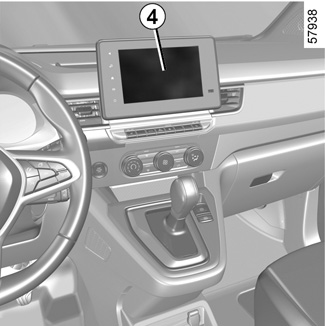
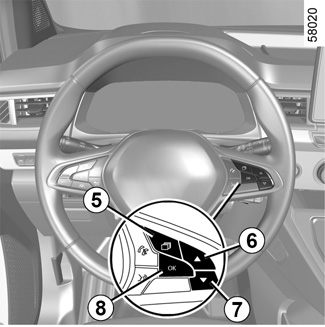
Systems A and B
Activation/deactivation
Vehicles fitted with a multimedia screen 4
To activate or deactivate the function, refer to the multimedia instructions.
Select “ON” or “OFF”.
Vehicles not fitted with a multimedia screen
- With the vehicle stopped, press the switch 5 as many times as required to reach the “Vehicle” tab;
- press the 6 or 7 control repeatedly to reach the “Settings” menu. Press the switch 8 OK;
- press the 6 or 7 control repeatedly to reach the “DRIVING ASSIST” menu. Press the switch 8 OK;
- press the 6 or 7 control repeatedly to reach the “Blind spot alert” menu and press the 8 OK switch;
- press the switch 8 OK again to activate or deactivate the function:
= function activated
< function deactivated
When the engine is started, the system recalls the last position stored before the ignition was switched off.
The system’s detection range operates according to a standard lane width. When driving in a narrow lane, the function can warn you when a vehicle is detected beyond the adjacent lane.
Systems A and B
(continued)
Operating faults
If the system detects a fault, the message “Check Side radars” is displayed on the instrument panel. Consult an approved dealer.
Due to the presence of radars or ultrasonic sensors (depending on the vehicle) behind the bumper, it is advisable to entrust any operation on the bumper (repair, replacement, paintwork etc.) to a qualified professional.
- The system’s detection range operates according to a standard lane width. If you are driving in wide traffic lanes, the system might not be able to detect a vehicle in the blind spot.
- The system might be disrupted momentarily if it is exposed to strong electromagnetic waves (as beneath high-tension power lines) or to very poor weather conditions (heavy rain, snow etc.). Remain aware of driving conditions.
There is a risk of accidents.
This function is an additional driving aid. This function is not under any circumstances intended to replace the due care and attention of the driver, who should at all times be in control of the vehicle.
The driver should always adapt their speed to the traffic conditions, regardless of the system indications.
The system should under no circumstances be taken to be an obstacle detector or an anti-collision system.
System servicing/repairs
- In the event of an impact, the alignment of the radars or ultrasonic sensors (depending on the vehicle) may be altered and their operation may consequently be affected. Deactivate the function and consult an authorised dealer.
- Any work (repairs, replacements etc.) in the area where the radars or ultrasonic sensors (depending on the vehicle) are located must be carried out by a qualified professional.
Only an authorised dealer is qualified to service the system.
System disturbance
Some conditions can disturb or damage the operation of the system, such as:
- complex surroundings (metal bridges, tunnels, roads with barriers at the edge, etc.);
- poor weather conditions (snow, hail, black ice, etc.).
Risk of false alarms or absence of warnings
In the event of the system behaving abnormally, deactivate it and consult an authorised dealer.
Limitation of the system operation
- The radars or ultrasonic sensors area (depending on the vehicle) should be kept clean and free of any modifications in order to ensure the proper operation of the system.
- Small objects moving close to the vehicle (motorcycles, bicycles, pedestrians, etc.) may not be recognised by the system.
- When turning into a bend, the radars or ultrasonic sensors (depending on the vehicle) may temporarily cease to detect vehicles in adjacent lanes.
- The function may warn you late if two other vehicles are approaching from the rear, driving side by side in the adjacent lanes (i.e. driving on a 3-lane road) at a much higher speed than your vehicle.
- The system may not provide a warning when the other vehicles are travelling at a significantly different speed.
- If the vehicle is being overtaken by a long vehicle (e.g. heavy goods vehicle overtaking at a similar speed to the vehicle) the system may interrupt the warning before the end of the manoeuvre.
- The vehicle is travelling on a winding road.
Deactivating the function
You must disable the function if:
- There has been damage in the area where the radars or ultrasonic sensors (depending on the vehicle) are located;
- the vehicle is fitted with a towbar that is not recognised by the system.